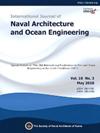A route planning method for small ships in coastal areas based on quadtree
IF 3.9
3区 工程技术
Q2 ENGINEERING, MARINE
International Journal of Naval Architecture and Ocean Engineering
Pub Date : 2025-01-01
DOI:10.1016/j.ijnaoe.2025.100647
引用次数: 0
Abstract
Route planning for large commercial ships generally revolves around economic factors, such as fuel consumption and travel distance, which are often influenced by maritime weather conditions. In contrast, small ships navigating coastal areas, such as yachts, prioritize safety and navigational convenience. Although extensive research has been conducted on route planning for commercial ships, more studies focusing on small ships are required. This study introduces a novel route planning method for coastal areas tailored to small ships. The proposed method begins by generating quadtree charts derived from an S-57 chart. Considering the lower computational performance typically observed for small ships, a quadtree chart offers a more efficient solution than a traditional regular grid. This structure allows for high-resolution representation only where necessary, considering water depth and coastal obstacles to ensure safe navigation. The route planning process comprises two layers: high-level and low-level. The high-level layer uses lower-resolution charts to outline a general route between the departure and arrival points and to identify key entrances along the way. The low-level layer, which employs higher-resolution charts, generates a detailed route from the departure point to the entrance and from the entrance to the arrival point. The final step involves smoothing to ensure a seamless and navigationally efficient route. Adopting a hierarchical approach can significantly enhance the efficiency of route planning by utilizing a multi-level structure, thereby reducing the time required for route planning. This methodology enables more effective responses in continuous maritime environments, ensuring high efficiency even during real-time route updates and modifications. The proposed method was applied to the coastal areas of the Republic of Korea to assess its effectiveness. In this study, the proposed method was compared with conventional chart generation methods. The results demonstrate that the method provides suitable and safe route planning for small ships, offering a reliable approach for coastal area navigation.

基于四叉树的沿海小型船舶航路规划方法
大型商船的航线规划通常围绕着燃油消耗和航行距离等经济因素,而这些因素往往受到海上天气条件的影响。相比之下,在沿海航行的小型船只,如游艇,优先考虑的是安全和航行便利。虽然对商业船舶航线规划进行了广泛的研究,但对小型船舶的航线规划还需要更多的研究。提出了一种适合小型船舶的沿海航线规划新方法。该方法首先从S-57图中生成四叉树图。考虑到小型船舶通常观察到的较低的计算性能,四叉树图提供了比传统规则网格更有效的解决方案。这种结构只在必要时才考虑到水深和海岸障碍,以确保安全航行。路由规划过程包括两层:高层和低层。高层使用低分辨率的图表勾勒出出发点和到达点之间的一般路线,并确定沿途的关键入口。低层采用更高分辨率的图表,生成从出发点到入口和从入口到到达点的详细路线。最后一步涉及平滑,以确保无缝和导航效率的路线。采用分层方法可以利用多层次的结构,大大提高路由规划的效率,从而减少路由规划所需的时间。这种方法可以在连续的海上环境中做出更有效的响应,即使在实时路线更新和修改期间也能确保高效率。提议的方法已应用于大韩民国沿海地区,以评估其有效性。在本研究中,将该方法与传统的图表生成方法进行了比较。结果表明,该方法为小型船舶提供了合适、安全的航路规划,为沿海地区航行提供了可靠的途径。
本文章由计算机程序翻译,如有差异,请以英文原文为准。
求助全文
约1分钟内获得全文
求助全文
来源期刊

International Journal of Naval Architecture and Ocean Engineering
ENGINEERING, MARINE-
CiteScore
4.90
自引率
4.50%
发文量
62
审稿时长
12 months
期刊介绍:
International Journal of Naval Architecture and Ocean Engineering provides a forum for engineers and scientists from a wide range of disciplines to present and discuss various phenomena in the utilization and preservation of ocean environment. Without being limited by the traditional categorization, it is encouraged to present advanced technology development and scientific research, as long as they are aimed for more and better human engagement with ocean environment. Topics include, but not limited to: marine hydrodynamics; structural mechanics; marine propulsion system; design methodology & practice; production technology; system dynamics & control; marine equipment technology; materials science; underwater acoustics; ocean remote sensing; and information technology related to ship and marine systems; ocean energy systems; marine environmental engineering; maritime safety engineering; polar & arctic engineering; coastal & port engineering; subsea engineering; and specialized watercraft engineering.
 求助内容:
求助内容: 应助结果提醒方式:
应助结果提醒方式:


